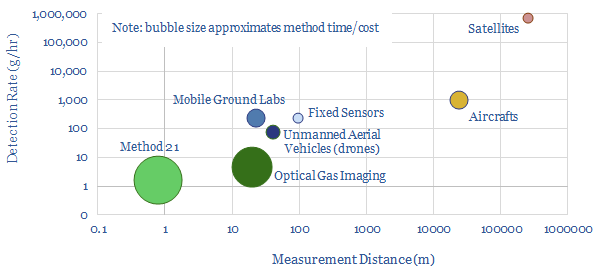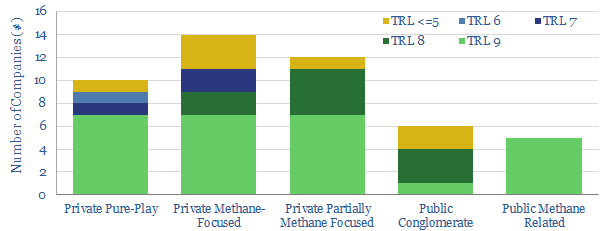This data-file is a screen of companies detecting methane leaks and manufacturing equipment to minimize methane leaks. Mitigating methane is an important theme to ensure low carbon intensity as natural gas scales up and displaces coal in the energy transition. So how is this done? And which companies are enabling progress?
Methods available to monitor for methane emissions include Method 21, Optical Gas Imaging, Laser Based Imaging, Fixed Sensors, Ground Labs, Aircraft Flyovers, Drone Surveys and Satellite imagery. Technical data are presented on these different topics in the data-file, for example, on spatial resolution, costs and success rates of some of these different options. Some examples are below.

But the main purpose of the file is to aggregate details, into a screen of companies detecting methane leaks and manufacturing equipment to minimize methane leaks.
Looking across the screen, 50 companies are noted in the data-file. Around one-third are public, and two-thirds are private. Around two-thirds are deploying technically ready solutions today, while others are in the trial phase.
More detailed case studies are also provided in the data-file. For example, we include a case study of Qube, which is an exciting company in advanced sensors, alongside peers such as Soofie and Earthview. Likewise, we included a case study of QLM, which is an exciting company in laser imaging, alongside peers such as Longpath and Mirico.
Operators are also screened, across the dozen largest Energy Majors, to estimate their methane leaks and broader methane intensity across the supply chain.
We have been adding to this screen continuously since 2019. Our sense is that the space is evolving very quickly. For example, in 2021-22, the EPA proposed new regulation, requiring operators to survey for methane leaks, bi-monthly, at 10kg/hr resolution, then to follow up with more sensitive methods to remediate any diagnosed leaks. Many of the companies that are now at commercial stages were founded in the 2015-20 timeframe. This suggests that as we continue updating the screen, more and more companies will be emerging.
In 2024, we screened a further dozen companies that are active in pressure sensing, which helps to improve oversight of the downstream gas distribution network. Sensing turns out to be a fascinating, $200bn pa industry, which is also crucial for greater digitization of industrial processes, benefitting from AI optimization, power grids and electric vehicle value chains.
Our note into mitigating methane in the energy transition remains a useful reference for the importance of this theme, and our key conclusions.
